This CDC olive fly is based on the pattern devised by Gwilym Hughes that won him honours at the 1998 River International on the River Tweed.
It was designed to match a hatch of blue-winged olives, but it also works as a general imitation of various olive flies.
I’ve been using this pattern for several years and found it’s a great dry fly for catching brown trout and grayling throughout the season and is now…
One of my Go-To fly patterns.
So, let’s take a look at…
How to tie the CDC Olive fly
Tying material list:
- Hook: Kamasan B100 #14 & 16
- Thread: Olive-brown 8/0
- Body: Wax olive-brown thread
- Rib: Fine gold wire
- Hot spot: Pearl Mylar
- Underwing: 6-8 deer hair fibre
- Wing: 3 Cul de Canard feathers
- Legs: Thread dubbed with Fox Squirrel
Step-by-step fly tying instructions:

Step 1. Place the hook firmly in the vice and start the thread 1mm behind the eye. Wind the thread in touching turns down the hook shank and catch in a length of fine gold wire.
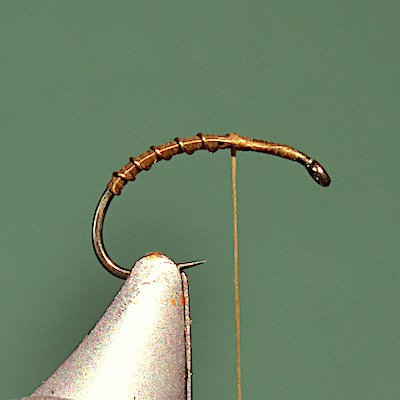
Step 2. Take the thread back up the hook shank stopping 4mm from the eye. Wind the gold wire up the hook in 4 – 5 open turns to form the rib. Tie off and remove the excess wire.
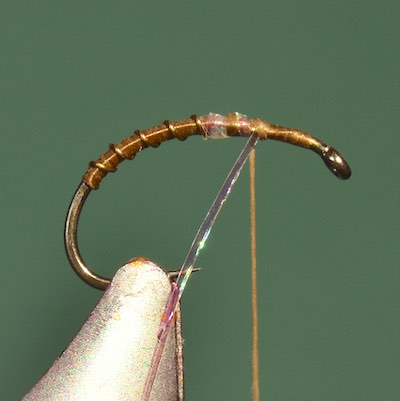
Step 3. Wax the silk thread and catch in a length of Mylar tinsel and form a 2 mm hot spot.
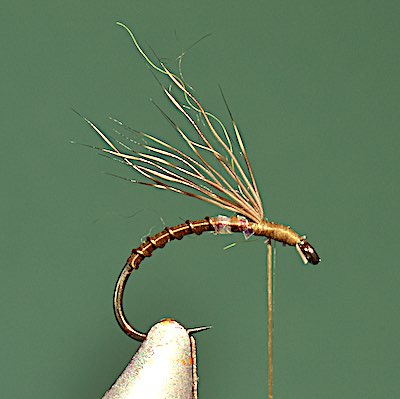
Step 4. To form the underwing, prepare a small bunch of deer hair and tie in with the waxed thread.

Step 5. Take 3 Cul de Canard feathers and match up their tips. Align the bunch of feathers on the hook with their tips protruding over the bend of the hook. Once in position, secure the feathers with the tying thread.
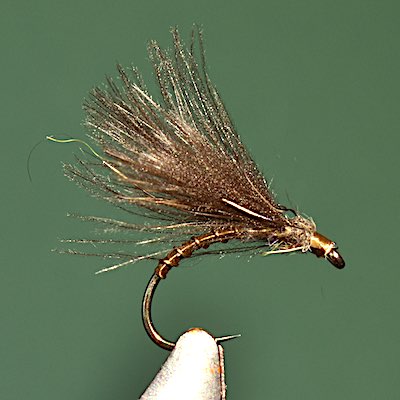
Step 6. Dub the tying thread with a small pinch of fox squirrel dubbing. In front of the CDC wing make two turns of the dubbed thread. Finally, form the head with the thread, whip finish, and apply a drop of varnish to the head.
The step of tying the deer hair under-wing is worth the effort because supports the Cul de Canard wing and aids the buoyancy of the fly.
I tie variations of this fly using a range of coloured tying threads from light olive to dark brown. These variations are useful when the standard pattern is refused.
Fishing the CDC olive fly
On wild rain-fed rivers and streams, dry fly fishing with this fly tied on the end of your leader is often the best approach for trout feeding on olives as they emerge.
It was originally designed to imitate blue-winged olives. However, I use this fly throughout the trout season and into the autumn grayling fishing season.
In March on the Welsh Dee, a size 12 fly is great for trout feeding on emerging Large Dark Olives. As the year progresses, hatching olive flies become smaller and therefore, it is best to use a smaller fly (#16).
I usually fish this fly in the slower sections of pools and riffles where trout and grayling are being selective.
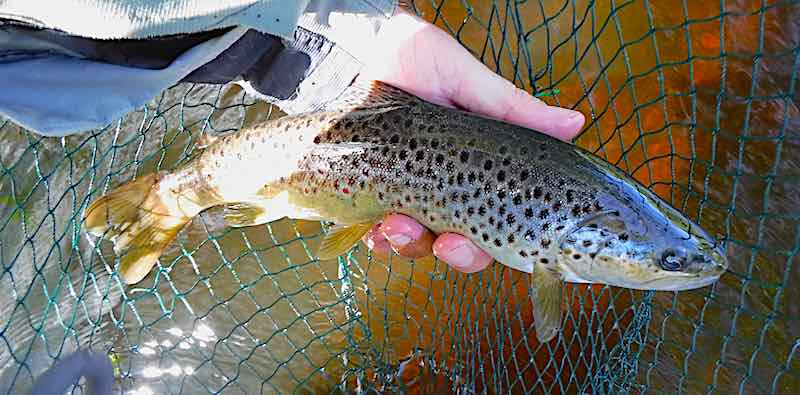
Equipment-wise, I use a 9ft 5# rod for dry fly fishing. Attached to the floating line is a 9ft 5X copolymer leader tipped with a 3 to 4 ft length of 3lb fluorocarbon.
It is important to apply Fullers Mud to the fluorocarbon tippet to remove its shine and make it sink. Whereas, Mucilin grease is applied to the remainder of the leader.
I don’t use floatant on CDC dry flies. Instead, when the fly becomes waterlogged, I dry it using a microfibre household cleaning cloth, make a couple of false casts, and it will return to riding high.
However, there are floatants available for CDC flies. For example, Loon Blue Ribbon is a pure floatant powder with nothing extra. Drop the fly with the tippet attached into the jar, close the lid and shake it a few times. The fly comes out with a powder coating that does a good job and doesn’t change the structure of the CDC feather.
Finally, I hope this article stimulates you to tie this CDC olive fly pattern and test it on your local river or take a trip to fish the Welsh Dee at Llangollen, where it catches plenty of spring brown trout.
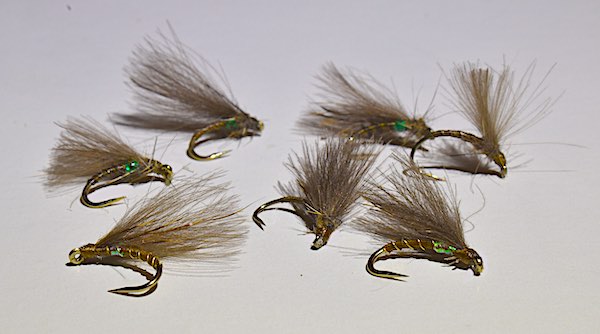
Lovely fly Andrew I think its position in the surface gives this the edge a proper trapped emerger , do you find the takes are more a gentle sip rather than a splashy , whole head out the water type
Hi James,
More often than not the bigger fish just sip the fly.
Cheers, Andrew
Shall be sitting at my bench in the morning tying a batch of these, hope they work on Dartmoor steams!
Hi Rob,
I’m sure they will for you on the Dartmoor streams when the olives start hatching.
Cheers, Andrew
This will be my first season trying dry fly so I have just started filling my fly box with dries. This is one that will be added. Thanks Andrew Not long now for the trout season to commence. Tight lines.
Hi Brian,
I hope you catch plenty of trout and grayling on them.
Cheers, Andrew
HI Andrew very nice looking fly
well explained and will be using this very soon
thanks for the post
Hi Colin,
I’m glad you enjoyed the post. Good look with the fly.
Cheers, Andrew
Thanks for posting this. I am going to give it a try. I am on the east coast of the US and I’ll let you know how it fishes.
Hi Fred,
Good luck and look forward to hearing how it performs.
Cheers, Andrew
Really nice fly I will definitely be trying it out
I hope it works well for you.
Cheers, Andrew
Hi,I like reading your blog and seeing the flies you tied. I’ve been three times since lockdown was lifted but only caught Grayling and Salmon parr.
Hi Sid,
There are lots of grayling in the river at the moment. They are feeding hard at the moment because I think they spawned early this year. If you want to avoid them and catch trout you need to search out the rocky pools and runs and avoid pools with large gravel sections, which grayling love.
I hope this helps and thanks for the comments on my blog.
Cheers, Andrew
Going to tie a few and try them on brookies.
That great. Let me know how you get on with them.
Cheers, Andrew
Hi Andrew , I always look forward to your fly tying posts , this is my first year fishing the Dee and l have already caught a few grayling but no brown trout yet . Tying some of your flies and fishing them the way you suggest gives me more confidence so I am sure it won’t be long before I catch a brown trout .
Please keep posting the fishing blogs they are much appreciated.
Hi Gary,
Great to hear you are enjoying the post and that they are helping you on the Dee.
Cheers, Andrew
Thanks again Andrew, apart from the customary useful and ey-to-follow tying instructions, I appreciate being introduced to flies that I’ve not used myself before – and how to use them! I imagine the trout up here in Derbyshire will not be averse to this pattern.
Hi Charles,
I’ve used the flies in Derbyshire and they work fine.
Andrew
Thanks Andrew, great looking fly, will have a go at these later,(when I’m back from the fishing)
Great to hear you found it interesting.
Andrew nice fly , I will tie a few of these and hopefully catch my first brown trout on the Dee fingers crossed.
You won’t be disappointed.
Great stuff Andrew, got my juices flowing in anticipation of the LDO hatches on my beloved Aberdeenshire Don, Haven’t done enough fishing for wild browns for a few seasons now, too pre-occupied with “chasing silver”, but will definitely give it a good shot this season inspired partly by your article. Thank you.
Hi Ash,
Great to hear it has inspired you to chase some early-season brown trout. I wish I was pre-occupied with chasing silver.
Tight lines, Andrew
Looks a great fly.
Good use of the deer hair to prop up the cdc
Just of to tie some of these , hopefully will try on the Aire next week . Looks like a really nice fly will try different threads as suggested maybe some different coloured wires too .Thanks Andrew .
Hi Martin,
Good luck and it would be great to know how you get on with them.
Tight lines, Andrew